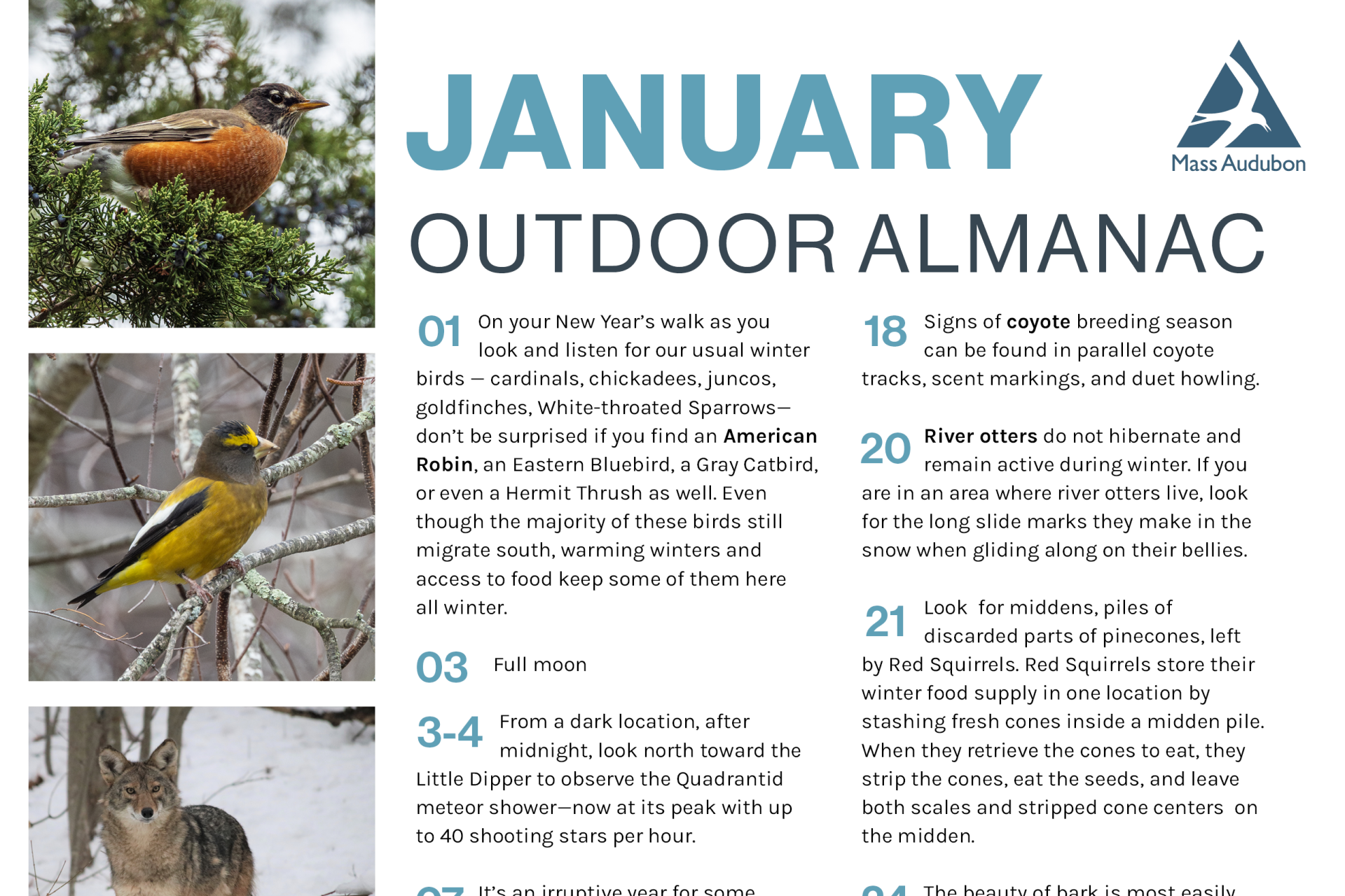Outdoor Almanac
January may be cold, but the natural world is anything but quiet. This month invites you to tune into winter’s subtle surprises—from unexpected songbirds lingering through the season to finches arriving from the north in search of food. Look up for a dazzling meteor shower, look down for otter slides and coyote tracks in the snow, and look closer at the hidden beauty of bark, cones, and winter roosts. Along the way, you’ll discover how frogs survive being frozen, where thousands of crows gather at dusk, and why Bald Eagles shift their winter hunting grounds. Bundle up and step outside—January is full of stories waiting to be noticed.
What will you discover this January? Visit a nearby wildlife sanctuary or join us for a program to make the most of your month.

Outdoor Almanac
Download or print this month's Outdoor Almanac.
JANUARY
1
On your New Year’s walk as you look and listen for our usual winter birds—cardinals, chickadees, juncos, goldfinches, White-throated Sparrows—don’t be surprised if you find an American Robin, an Eastern Bluebird, a Gray Catbird, or even a Hermit Thrush as well. Even though the majority of these birds still migrate south, warming winters and access to food keep some of them here all winter.
3
Full moon
3-4
From a dark location, after midnight, look north toward the Little Dipper to observe the Quadrantid meteor shower—now at its peak with up to 40 shooting stars per hour.
7
It’s an irruptive year for some finches. Typically, finches overwinter in the boreal forests of Canada, where their preferred seed crops are usually plentiful. However, this year, those northern food supplies are coming up short, drawing them farther south in search of food. Keep an eye out for Purple Finch, Redpoll, Red Crossbill, Pine Siskin, and Evening Grosbeak.
10
Gray Treefrogs spend the winter hibernating under leaf litter, rocks, and rotting logs. There they survive the bitter cold (as low as –20 degrees F) and can freeze up to 40 percent of their bodies, thaw, and refreeze, repeating the cycle a handful of times.
14
In winter, American Crows roost together every night. Roost locations change over time, but most recently there are large roosts with thousands of birds in Lawrence and Springfield. If you are near either city in the late afternoon and notice large numbers of crows flying about, they are staging before settling into their chosen roost trees for the night.
18
Signs of coyote breeding season can be found in parallel coyote tracks, scent markings, and duet howling.
20
River otters do not hibernate and remain active during winter. If you are in an area where river otters live, look for the long slide marks they make in the snow when gliding along on their bellies.
21
Look for middens, piles of discarded parts of pinecones, left by Red Squirrels. Red Squirrels store their winter food supply in one location by stashing fresh cones inside a midden pile. When they retrieve the cones to eat, they strip the cones, eat the seeds, and leave both scales and stripped cone centers on the midden.
24
The beauty of bark is most easily appreciated in winter. Look for the distinctive coverings of white ash (interconnected narrow diamonds), quaking aspen (pale, grayish green, smooth on the branches and rough on the older trunk), American beech (silvery gray and very smooth), and yellow birch (shiny, amber brown to creamy silver that peels into shreddy rolls on mature trunks).
30
When ice forms on interior lakes, Bald Eagles move to river mouths along the coast where they can fish in the open water. The mouth of the Merrimack often has several wintering eagles.
Upcoming Programs this Month
See MoreFamily Winter Birding
-
Boston Nature Center and Wildlife Sanctuary, Mattapan
-
9 classes starting
Saturday, January 3
10:30am-12:00pm
Families - children 0 - 17
New Year's Hike
-
Wachusett Meadow Wildlife Sanctuary, Princeton
-
Saturday, January 3
1:00-3:00pm
Adults
Owl Prowl
-
Long Pasture Wildlife Sanctuary, Cummaquid
-
Saturday, January 3
3:30-5:00pm
Adults & Families - 10 - 17
Full Moon Owl Prowl
-
Felix Neck Wildlife Sanctuary, Edgartown
-
Saturday, January 3
4:15-5:15pm
Adults & Families - 0 - 17
Full Moon Hike
-
Wachusett Meadow Wildlife Sanctuary, Princeton
-
Saturday, January 3
5:00-6:30pm
Adults & Families - 12 - 17
Destination Birding With a Scone: Rexhame Beach
-
Rexhame Beach, Marshfield
-
Tuesday, January 6
8:00-11:00am
Adults
Stay Connected
Don't miss a beat on all the ways you can get outdoors, celebrate nature, and get involved.



